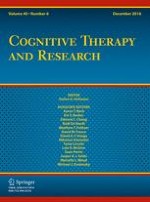03-06-2016 | Original Article
An Examination of the Specific Associations Between Facets of Difficulties in Emotion Regulation and Posttraumatic Stress Symptom Clusters
Gepubliceerd in: Cognitive Therapy and Research | Uitgave 6/2016
Log in om toegang te krijgenAbstract
Prior research has shown that difficulties in emotion regulation is associated with overall levels of posttraumatic stress symptoms (PTSS). However, it is currently unclear which facets of difficulties in emotion regulation (e.g., lack of emotion regulation strategies, impulse control problems, non-acceptance of emotional responses) are associated with specific PTSS clusters. This information may be valuable in refining treatment approaches in PTSS. The aim of the current study was to use structural equation modeling to test the relationships between Difficulties in Emotion Regulation Scale (DERS) subfactors and PTSS in a trauma-exposed community sample (N = 746). Results indicated that impulse control difficulties were most consistently associated across PTSS clusters (i.e., re-experiencing, avoidance, and hyperarousal), while lack of emotion regulation strategies and emotional clarity were uniquely associated with numbing symptoms, after covarying for neuroticism. However, other facets of difficulties in emotion regulation (i.e., non-acceptance of emotional responses and difficulties engaging in goal-directed behavior while upset) were not associated with PTSS. These findings provide further support for the role of difficulties in emotion regulation in specific PTSS clusters. Additionally, they suggest that impulse control problems may be important in the development of most PTSS and thus most beneficial to target clinically, while lack of emotional clarity and effective emotion regulation strategies may be specific to numbing symptoms.
